植物膜结合转录因子的细胞内转运及其成像方法
IF 6
2区 生物学
Q1 PLANT SCIENCES
引用次数: 2
摘要
摘要膜结合转录因子(MTFs)不同于胞质转录因子(TF),它们天生与膜结合。在外部刺激下,MTF从各种膜中释放出来,转化为活性形式,并被转运到细胞核中进行转录调控。因此,与大多数TF不同,MTF经历了从膜向细胞内区域过渡的独特过程。这一时期有两种典型的机制:蛋白水解加工和选择性剪接。然而,最近也出现了其他激活方案。为了进一步了解这些机制,研究MTF如何在细胞内运输并进入细胞核至关重要。高时空分辨率的成像技术可以部分解决这一过程,但未来的研究还需要新的方法。在这篇综述中,我们概述了植物MTF的当前知识,包括它们的识别、特异性定位以及研究它们的细胞动力学的困难。我们还讨论了MTF释放的分子机制和先进的方法,如荧光相关光谱、单粒子跟踪和光活化定位显微镜,以进一步揭示它们在活细胞中的细胞内运动。本文章由计算机程序翻译,如有差异,请以英文原文为准。
Intracellular Trafficking and Imaging Methods of Membrane-Bound Transcription Factors in Plants
Abstract Membrane-bound transcription factors (MTFs) differ from cytosolic transcription factors (TFs) and they innately bind to membranes. Under external stimuli, MTFs are released from various membranes, convert into the active form, and are transported into the nucleus for transcriptional regulation. Therefore, unlike most TFs, MTFs go through the unique process of transitioning from the membrane to intracellular regions. There are two typical mechanisms during this period: proteolytic processing and alternative splicing. However, other activation schemes have also recently emerged. To further understand these mechanisms, it is essential to study how MTFs transport within the cell and into the nucleus. Imaging techniques with high spatiotemporal resolution can partially resolve this process but new methods are required for future studies. In this review, we give an overview of the current knowledge of plant MTFs, including their identification, specific localization, and the difficulties in studying their cellular dynamics. We also discuss molecular mechanisms of MTF release and advanced methods, such as fluorescence correlation spectroscopy, single-particle tracking, and photoactivated localization microscopy, to further reveal their intracellular movement in living cells.
求助全文
通过发布文献求助,成功后即可免费获取论文全文。
去求助
来源期刊
CiteScore
12.90
自引率
1.40%
发文量
15
审稿时长
>12 weeks
期刊介绍:
Critical Reviews in Plant Sciences focuses on presenting in-depth and up-to-date reviews of timely and/or cutting-edge subjects in the broad discipline of plant science, ranging from molecular biology/biochemistry through the areas of cell biology, plant pathology and physiology, genetics, classical botany, and ecology, to practical agricultural applications. Articles in the journal provide an up-to-date literature base for researchers and students, pointing the way towards future research needs. The journal is also a significant source of credible, objective information to aid decision makers at all levels.

 求助内容:
求助内容: 应助结果提醒方式:
应助结果提醒方式:


